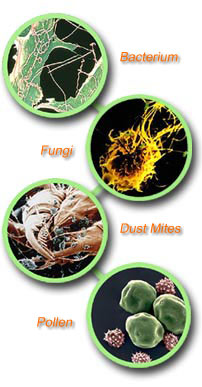|
'Sick building syndrome' leads to a variety
of sympton, but cause are up in the air
WHAT
IS INDOOR AIR QUALITY?
IAQ has become one of the leading environmental issues of
the '90's. Studies have shown that the concentrations of hazardous
of pollutants are often many times higher indoors than out-of-doors.
Why is there a problem with the quality of the air? As construction
method responded to the increasing costs of energy, modem
buildings have reduced levels of "leakage" or "infiltration
of fresh air.
Buildings
with tighter construction are more energy efficient to operate.
This energy efficiency comes with a trade-off, less fresh
air in the building. Reductions in fresh air exchanges result
in a building with "stale" air. The chemicals present
in the building and gases produced by the furnishings and
contents are no longer diluted by fresh air. The level of
purity, and quality of the air has become reduced.
HOW
CAN THE PROBLEM BE HANDLED?
IAQ problems are multi-faceted and require solutions and skills
in many areas. Cleaning and maintenance of the floors and
capering is just the beginning. The March of 1993 issue of
PCJ took an in-depth look at ceiling and wall cleaning. Contractors
offering this service are experiencing a "wave of growth".
This service removes the pollutants and by products from the
interior surfaces that are present in buildings with a poor
IAQ environment. PCJ July 1993 looked at the care and cleaning
of blinds and other window treatments, another service to
remove the pollutants from surfaces of the building's interior.
All these cleaning services improve the quality level of the
indoor environment, but what about the air duct system. As
stated earlier, the air duct system is the "lungs"
of the building. Cleaning all surfaces of the interior space
without cleaning the air duct system would be like "putting
a clean sock on a dirty Foot". The air duct system will
simply recontaminate the newly cleaned areas it recirculates
air within the building.
Indoor air quality is the environmental issue of the 90's.
The USEPA has ranked poor IAQ as one of the highest risks
to human health among all types of environmental problems.
In fact, according to studies conducted by EPA, NIOSH and
others, the average measured levels of many hazardous pollutants
may be as much as 100 times higher in indoor air then in the
air outside.
The World Health Organization has estimated that 30% of all
buildings experience IAQ problems. These problems are especially
prevalent in tight, energy-efficient buildings where a high
percentage of recalculated air is utilized. According to the
highly respected Journal of American Medical Association:
"the risk of respiratory infection is 45% higher among
occupants of energy efficient buildings."
|
|
See
Figures
Enlarged samples taken by microscope from top to buttom:
Bacterium, Fungi, Dust Mites and
Pollen. These pollutants can circulate freely through
the air ducts and air conditioning system,
which are poorly or improperly maintained. 42,000 dust mites
can be found in 1 ounce of dust. |

